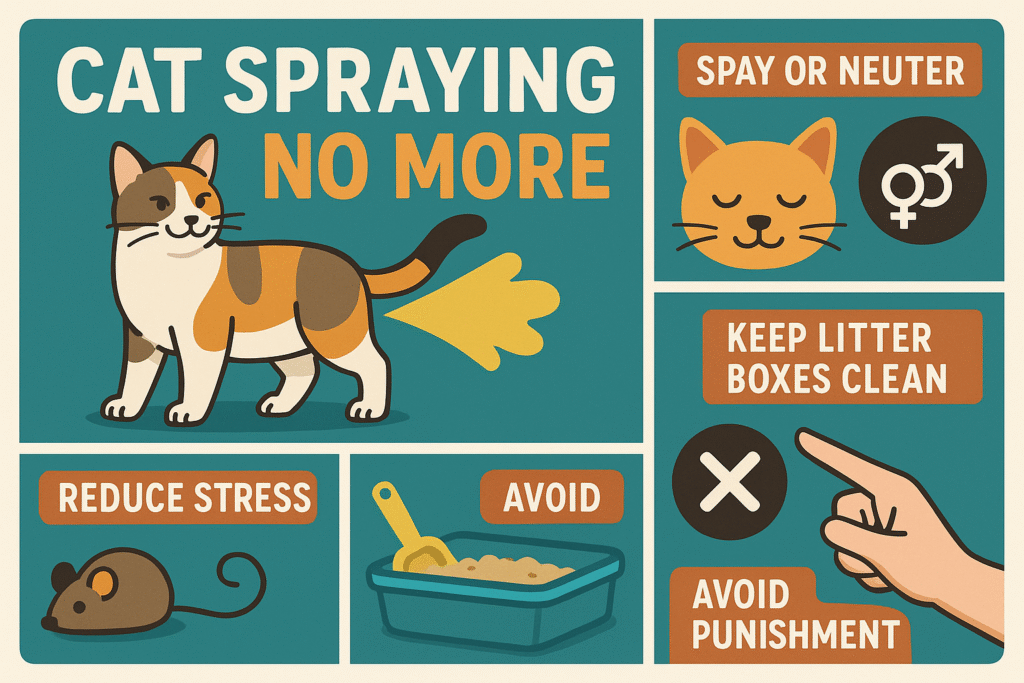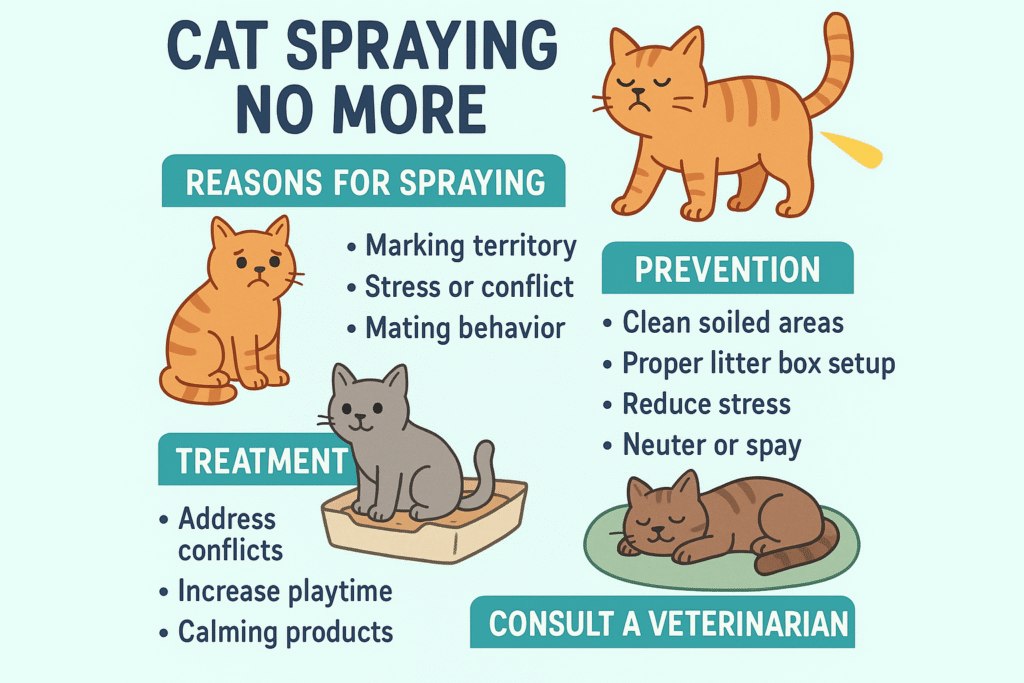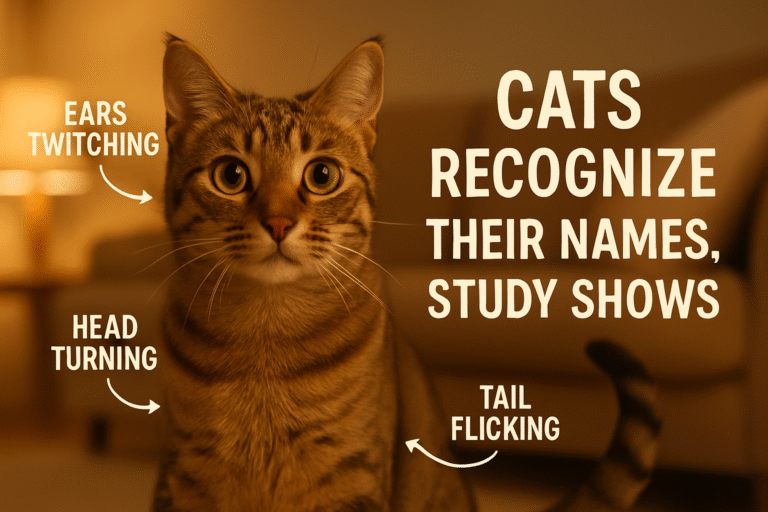
Cat Spraying No More Review: Stop Cat Marking Effortlessly
For many cat owners, discovering a fresh puddle or spray mark in the corner of a room is a gut‑wrenching experience. Cat spraying and inappropriate urination aren’t merely inconvenient—they can cause permanent damage to carpets, hardwood floors, upholstery, and personal belongings. Beyond the physical destruction, these behaviors often signal deeper issues, such as stress, health concerns, or social tension. When left unchecked, spraying can erode your bond with your feline companion and even lead to rehoming or behavioral euthanasia in extreme cases.
Table of Contents
ToggleAccording to veterinary surveys, up to 15% of domesticated cats exhibit spraying behaviors at some point in their lives.¹ This statistic underscores a widespread challenge: millions of homes battle recurring odor issues, costly cleanups, and the emotional toll of feeling unable to help a treasured pet. The ripple effect spans financial burdens—professional odor removal can cost hundreds per service call—to emotional strain, as owners wrestle with frustration, guilt, and helplessness.
Cat Spraying No More™ emerges as a lifeline for cat enthusiasts determined to reclaim a clean, harmonious household. Developed by a seasoned feline behaviorist, this digital comprehensive program blends cutting‑edge animal psychology research with actionable, real‑world strategies. Rather than applying generic advice or temporary fixes, the system guides you through identifying the precise cause of your cat’s spraying and implementing tailored interventions. This review offers a deep dive into the program’s philosophy, structure, scientific underpinnings, and practical applications—arming you with the knowledge to decide if Cat Spraying No More™ can transform your relationship with your cat and your living space.

End Cat Spraying for Good!
Discover a proven, step-by-step system to stop unwanted marking, banish odors, and bring peace back to your home—risk-free with a 60-day guarantee.
What Is Cat Spraying No More™?
At its essence, Cat Spraying No More™ is an online behavioral training and environmental management system designed to eliminate unwanted spraying and litter‑box aversion. Created by Dr. Sarah Ellis, DVM, a board‑certified veterinary behaviorist with over 12 years of clinical practice, the program synthesizes veterinary medical insights, ethological research, and applied behavior analysis.
Key components include:
Core Training Manual (Approximately 180 pages)
- Explains feline communication, the role of scent marking, and how stress hormones influence behavior.
- Provides step‑by‑step behavior‑modification protocols, leveraging positive reinforcement and desensitization techniques.
Modular Action Plans
- Single‑Cat Module: Focuses on strengthening your cat’s sense of security, optimizing litter‑box placement, and introducing low‑stress environmental enrichment.
- Multi‑Cat Module: Addresses social hierarchies, resource guarding, and inter-cat tension by recommending spatial distribution of resources and conflict‑reduction exercises.
- Adoption & Transition Module: Offers gradual acclimation strategies for newly adopted cats, integrating scent exchange, controlled access, and structured play to ease anxieties.
- Environmental Change Module: Guides you through moves, renovations, and sudden household changes, using progressive exposure, familiar scent swabs, and comfort‑zone creation.
Odor Elimination Blueprint
- Enzyme‑Based Cleaner Formulas: Four proven, non‑toxic recipes with step‑by‑step mixing instructions (e.g., measuring 1 part natural enzyme concentrate to 4 parts distilled water).
- Surface‑Specific Protocols: Detailed cleaning methods for high‑risk areas—carpets (pre‑treatment with borax blend), hardwood floors (vinegar and enzyme soak), upholstery (microfiber steam infusion), and painted walls (spray‑on enzyme solution).
- Preventive Upkeep Checklists: Weekly and monthly odor audits to catch and treat fresh marks before they embed.
Supplemental eBooks
- The Cat Enrichment Compendium: Over 50 DIY toy tutorials, vertical territory designs, and interactive puzzle feeders proven to lower stress hormones and reduce marking impulses.
- Nutrition & Wellness Guide: Tailored meal plans, supplement recommendations (e.g., L‑theanine chewables), and hydration protocols to support urinary tract health.
- Health & Behavior Tracker: Printable logs and simple spreadsheet templates for monitoring litter‑box usage, mood indicators (purring frequency, play engagement), and vet appointments.
- Bond‑Building Playbook: Structured play schedules, clicker‑training primers, and natural foraging simulations to deepen trust and redirect energy.
All materials are instantly accessible via secure download links in PDF format, compatible with desktops, tablets, or smartphones. A lifetime subscription model grants ongoing updates whenever new veterinary research or behavioral techniques emerge.
The Science and Strategy Behind Cat Spraying No More™
Understanding the scientific rationale behind the system illuminates why it outperforms quick‑fix solutions:
Feline Chemical Communication
Cats rely heavily on olfactory signals. Their scent glands—located in cheeks, paws, and anal sacs—imbue urine and pheromone deposits with personalized chemical messages. When a cat sprays, it’s broadcasting territorial boundaries or signaling emotional states to both conspecifics and human cohabitants.
Cat Spraying No More™ leverages this innate communication by:
- Redirecting marking impulses toward designated scratching posts infused with synthetic feline pheromone analogs (e.g., Feliway® replicates).
- Pairing odor‑free zones with positive stimuli (food treats, gentle petting) to reprogram the cat’s cognitive association between the litter box and comfort.
Operant Conditioning and Desensitization
Behavioral change hinges on two pillars:
- Reinforcement Schedules: The program prescribes specific reward schedules—starting with continuous reinforcement (treat each correct use) and gradually shifting to variable‑ratio schedules to foster sustained compliance.
- Systematic Desensitization: By controlling proximity to stressors (e.g., limiting window access where outdoor cats loiter), the methodical exposure lowers anxiety-triggered spraying over time.
Stress Hormones and Biorhythms
Chronic stress elevates cortisol and adrenaline, exacerbating marking behaviors. The program addresses this by recommending:
- Environmental Enrichment: Vertical climbing shelves and hiding boxes to provide refuge and reduce perceived threats.
- Routine Stabilization: Consistent meal times and play sessions aligned with the cat’s natural crepuscular activity peaks (dawn and dusk) to balance circadian rhythms.
These science‑driven tactics ensure that interventions aren’t merely superficial but reshape the cat’s neurological and emotional responses to its environment.

Master Home Pet Training & Health with Kingdom of Pets
Kingdom of Pets delivers expert-curated, science-backed online obedience and health‐care courses for dogs, cats, and more—complete with a FREE 6-day “Secrets to Dog Training” program and a vibrant community of pet lovers—all accessible from the comfort of your home.
Detailed Walkthrough: How the Program Works
Cat Spraying No More™ organizes its methods into four progressive phases. Here’s a closer look at each:
Phase 1: Personalized Assessment
Within the first 48 hours of purchase, you complete an extensive online questionnaire designed to capture:
- Behavioral Baseline: Tracking the frequency, location, and situational context of each spraying incident.
- Medical History Check: Vet records review, including prior urinary tract diagnoses, kidney function tests, and joint health assessments.
- Environmental Audit: Room dimensions, airflow patterns, and sun exposure—all factors in feline comfort.
The assessment output is a customized report mapping out your cat’s risk factors and suggested priority interventions. This report serves as a roadmap for all subsequent steps.
Phase 2: Module Implementation
Based on your assessment, you’ll engage with one or more of the four modules. Each module includes:
1. Action Plan Checklist
- Daily tasks (e.g., clean litter box at least twice daily; rotate scratching pad positions weekly).
- Weekly targets (e.g., record five litter‑box entries in the tracker app; introduce a new puzzle feeder).
2. Behavioral Exercises
- Clicker Training for Litter Use: Step-by-step guidance on pairing clicker sounds with box visits, gradually shaping consistent behavior.
- Stress‑Reduction Sessions: Short guided massage techniques and ambient music playlists (e.g., classical compositions shown to calm cats).
3. Environmental Adjustments
- Optimal placement of litter boxes (one plus one per cat, ideally in quiet, low-traffic zones).
- Strategic use of pheromone diffusers near high‑stress points (entryways, windows overlooking other animals).
Users receive printable worksheets and digital reminders (optional email prompts) to stay on track. The transparent structure fosters accountability and momentum.
Phase 3: Odor Neutralization
Even if spraying stops, residual odors can lure your cat back to the same spot. This phase provides:
- Four Signature Formulas: Each formula uses a different enzyme source (bacterial, fungal, plant-derived) to ensure efficacy across diverse surface materials.
- Application Protocols: Instructions specify dwell times (e.g., allow enzyme solution to soak for 15–20 minutes), agitation methods (soft-bristle brush vs. gentle spray mist), and drying techniques (towel blotting vs. air‑dry).
- Maintenance Schedules: Guidance for treating low-level odors weekly to prevent reestablishment of marking patterns.
Phase 4: Monitoring, Maintenance, and Modification
Behavioral change is dynamic. This final phase equips you with tools to:
- Track Progress: Use the digital Health & Behavior Tracker to log incidents, record litter-box visits, and note environmental changes.
- Adapt Strategies: If incidents persist, the program offers troubleshooting flowcharts—e.g., if stress-related spraying continues after three weeks, escalate pheromone diffuser usage or veto specific stressors (like neighborhood cats).
- Seek Veterinary Collaboration: Clear guidelines on when to consult a veterinarian for diagnostic imaging or additional medical intervention.
By the end of this phase—typically eight to twelve weeks—most cats show a dramatic decline or complete cessation of spraying behaviors.
Unlock Your Dog's Hidden Intelligence with Brain Training for Dogs
Complementary Enrichment Strategies
To bolster the core program, Cat Spraying No More™ recommends integrative enrichment methods that address your cat’s physical and emotional needs:
Vertical Territory Design
Install shelving systems and window perches. Cats feel safer and mark less when they can oversee their environment from elevated vantage points.
Interactive Play and Puzzle Feeders
Schedule at least two 10‑minute play sessions daily. Use wand toys and laser pointers—end sessions with a tangible reward to prevent frustration.
Auditory and Olfactory Stimulation
Play nature soundtracks (birdsong, rainfall) during the day and rotate aromatic plant sachets (catnip, valerian) in safe, supervised areas to engage multiple senses.
Dietary Adjustments
Transition to urinary‑health diets containing controlled magnesium levels and increased moisture content. Implement portion control to prevent obesity, a known exacerbator of urinary issues.
These supportive strategies enrich your cat’s life, reduce boredom-induced spraying, and reinforce positive behaviors initiated in Phases 1–4.
Detailed Enzyme Cleaner Recipes
Achieving long‑term odor control demands precise cleaning protocols. Here are two flagship recipes:
Recipe A: Bacterial Enzyme Solution
Ingredients:
- 1 cup distilled water
- ¼ cup white vinegar
- 1 tablespoon baking soda
- 1 teaspoon commercially available bacterial enzyme concentrate
Instructions:
- Mix distilled water and white vinegar in a spray bottle.
- In a separate container, dissolve baking soda in a small amount of warm water.
- Combine both solutions and add the enzyme concentrate.
- Shake gently to incorporate.
Application: Spray liberally on the affected area. Allow to soak for 20 minutes, then blot with a clean cloth. Repeat if needed.
Recipe B: Plant‑Derived Enzyme Cleaner
Ingredients:
- 1 liter lukewarm water
- ½ cup lemon juice
- 2 teaspoons ground papaya powder (rich in papain enzyme)
- 5 drops tea tree oil (antimicrobial)
Instructions:
- Warm the water and stir in lemon juice.
- Gradually whisk in papaya powder until fully dissolved.
- Add tea tree oil and mix.
Application: Use a soft brush to work the solution into carpets or upholstery. Let air‑dry for at least 2
Safety Note: Always test a small, inconspicuous area first to ensure colorfastness and material compatibility.
Unlock Your Dog's Hidden Intelligence with Brain Training for Dogs
Pricing, Support, and Guarantees
Investment: $37 one‑time payment for lifetime access to all current materials and future updates. No subscription or ongoing fees.
Payment Options:
- Secure checkout via credit/debit cards or PayPal.
- Instant access links delivered via email.
Customer Support:
- Email Assistance: Access to a support team specializing in troubleshooting technical download issues or clarifying program steps.
- Community Forum: Entry into a private online group of fellow cat owners sharing tips, progress updates, and encouragement.
Guarantee:
60‑Day, No‑Questions‑Asked Refund. If you follow the program as outlined and see no measurable reduction in spraying within two months, you can claim a full refund.

👍 Pros and 👎 Cons
✅ Pros:
- Evidence‑Based: Founded on peer‑reviewed veterinary and ethological research.
- Holistic: Integrates medical, behavioral, and environmental interventions.
- Scalable: Works for single cats or complex multi‑cat families.
- Cost‑Effective: One‑time fee versus recurring professional services.
- Comprehensive: Over 300 pages of materials, stepwise modules, and ongoing updates.
❌ Cons:
- Time Investment: Requires consistent daily or weekly tasks for optimal results.
- Digital Format: No physical printouts—depends on device availability.
- DIY Cleaning: Some owners may prefer off‑the‑shelf products over homemade enzyme solutions.
On balance, owners committed to following the structured program will likely find the benefits far outweigh any drawbacks.
Conclusion
Cat Spraying No More™ transcends band‑aid fixes by offering a meticulously researched and systematically applied solution to feline spraying. Its layered approach—encompassing tailored assessments, behavior modification science, targeted enrichment, and advanced odor neutralization—addresses both the symptoms and root causes of this challenging behavior.
If you’re ready to reclaim a fresh, clean home environment and strengthen your partnership with your cat, Cat Spraying No More™ provides the roadmap. With a satisfaction guarantee, responsive support, and lifetime access, this program represents a low‑risk, high‑reward investment in your cat’s well‑being and your peace of mind.
Take the first step toward a spray‑free life today: Visit CatSprayingNoMore.com
Frequently Asked Questions (FAQs)
What is Cat Spraying No More™?
A comprehensive digital program developed by certified behaviorists that uses assessment tools, behavior-modification techniques, enrichment strategies, and odor-neutralizing recipes to eliminate unwanted spraying in cats.
How quickly can I expect to see results?
Most users report noticeable reductions in spraying within 1–2 weeks; full resolution typically occurs within 8–12 weeks when all steps are followed consistently.
Does it work for multi-cat households?
Yes. The program includes a dedicated Multi-Cat Module with protocols for litter-box distribution, resource placement, and stress reduction to address inter-cat marking.
Are the cleaning formulas safe for my family and pets?
Absolutely. All enzyme-based cleaner recipes use non-toxic, natural ingredients that are safe around cats, children, and food areas once properly applied and dried.
Do I need to buy any special equipment or products?
No. You only need standard household items (vinegar, baking soda, distilled water, etc.) and optional pheromone diffusers or clicker tools for advanced reinforcement, though these are not mandatory.
What if my cat’s spraying is caused by a medical issue?
The program advises an initial veterinary checkup. It includes pathways for combining medical treatment (e.g., antibiotics for UTIs) with behavioral interventions for best results.
Is there live coaching or support?
While there is no one-on-one coaching, you get email support for technical or program-related questions and access to a private online community of fellow cat owners.
Can I access the materials on my phone or tablet?
Yes. All guides and modules are delivered as downloadable PDFs, compatible with any internet-connected device for convenient reference.
What happens after the 60-day money-back guarantee?
You maintain lifetime access to all current and future program updates at no additional cost. The guarantee simply ensures a risk-free trial period.
Will the program help prevent future spraying relapses?
Yes. With its maintenance checklists, enrichment recommendations, and periodic odor audits, the system equips you to catch and address new marking behaviors before they become habitual.
Recent Posts









Related Topics
Copyright © 2025 The Pet Blog – Expert Tips, Care Guides & Fun Facts for Every Pet Lover.


